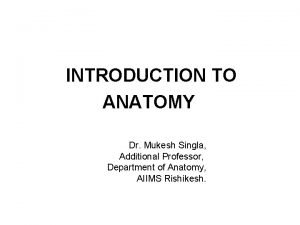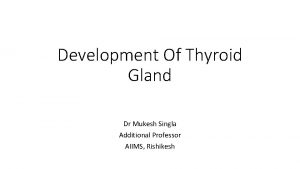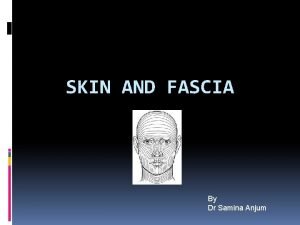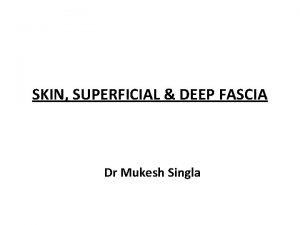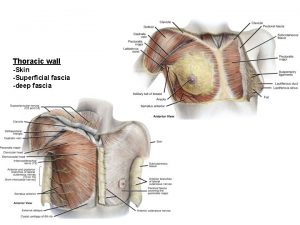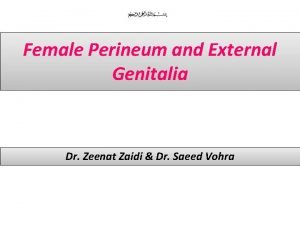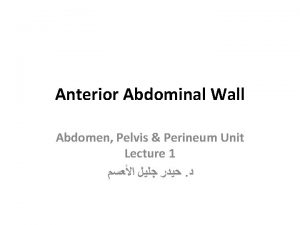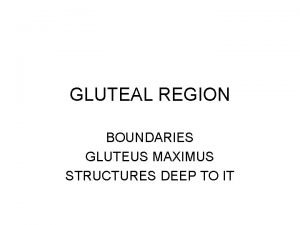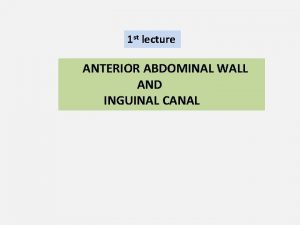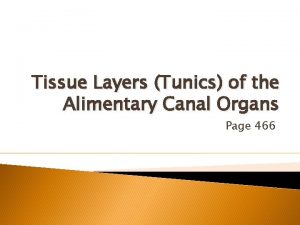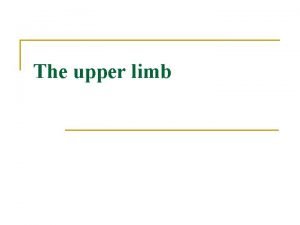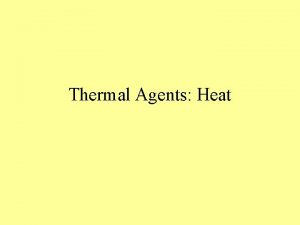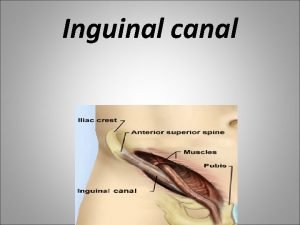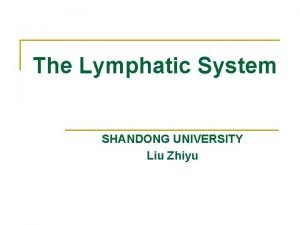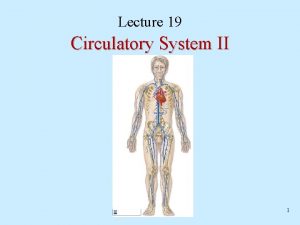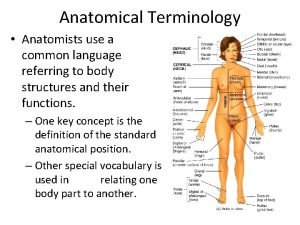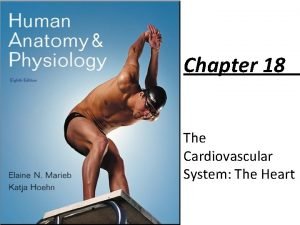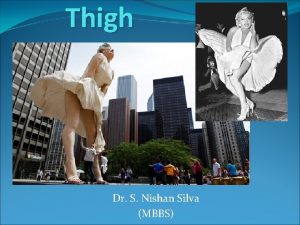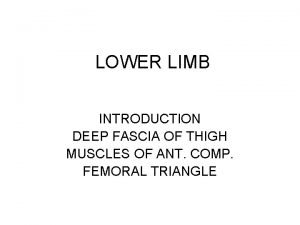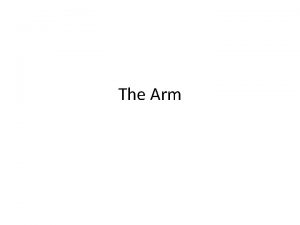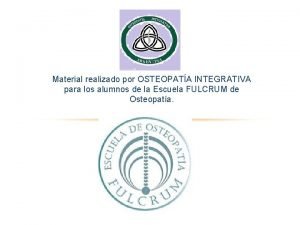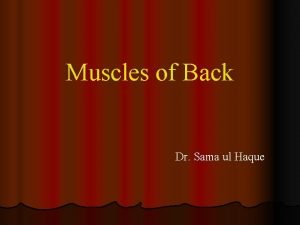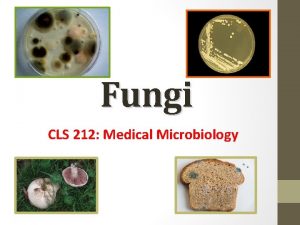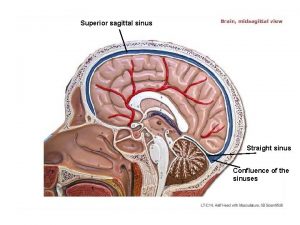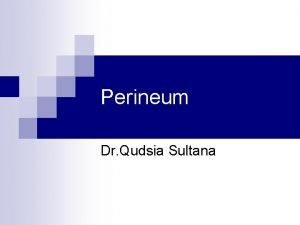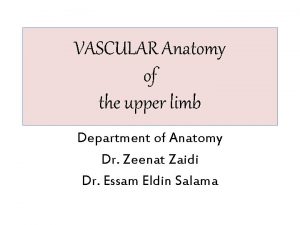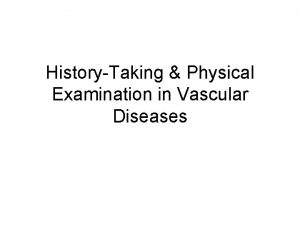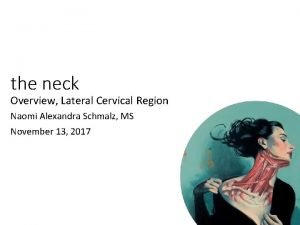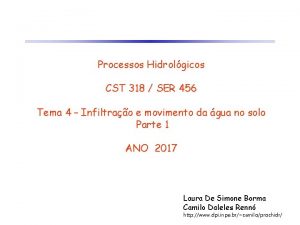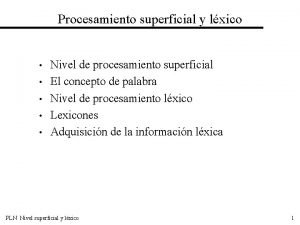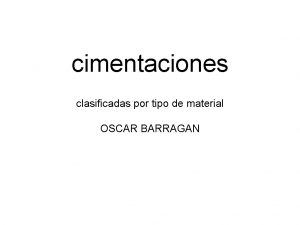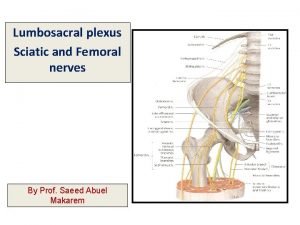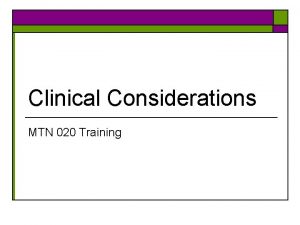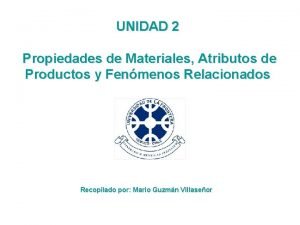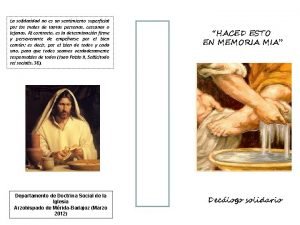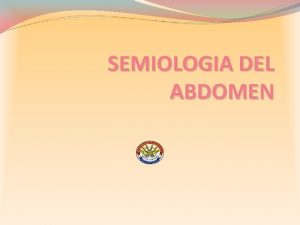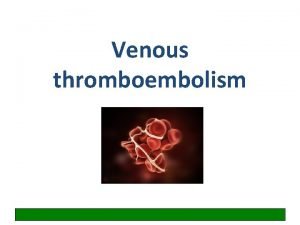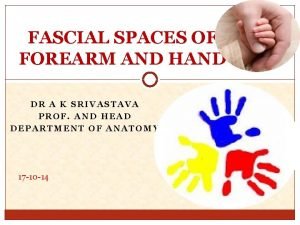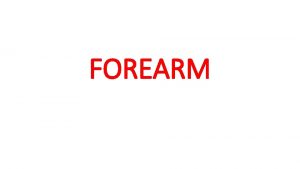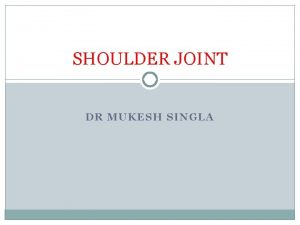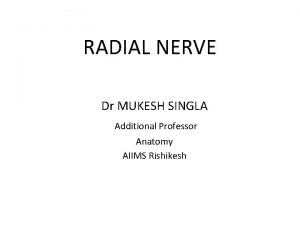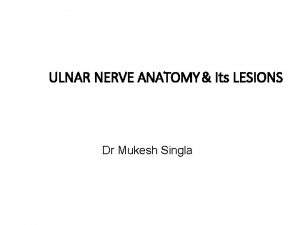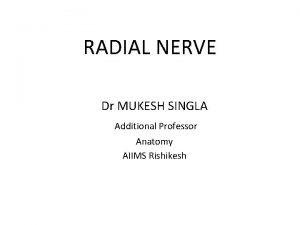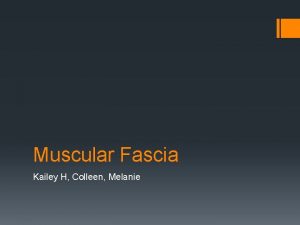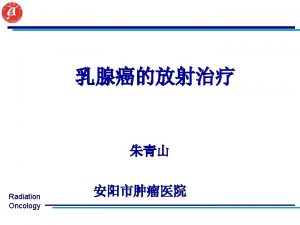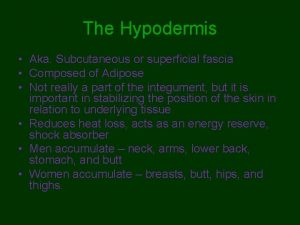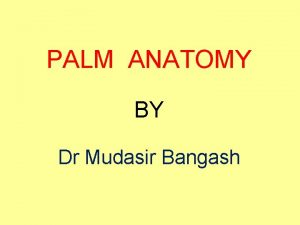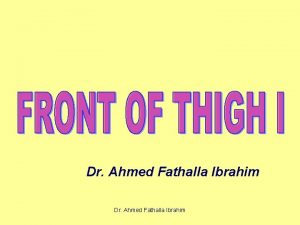SKIN SUPERFICIAL DEEP FASCIA Dr Mukesh Singla SKIN








































































- Slides: 72

SKIN, SUPERFICIAL & DEEP FASCIA Dr Mukesh Singla

SKIN

DEFINITION • • • GENERAL COVERING OF THE EXTERNAL SURFACE OF THE BODY FORMS 15% OF THE TOTAL BODY WEIGHT THICKNESS-1. 5 to 5. 0 mm LARGEST ORGAN OF THE BODY

INTEGUMENTARY SYSTEM

Some Facts about Skin • Surface area: 1. 5 -2. 0 sq meters • Growth rate of nail: 0. 1 mm per day • Growth rate of hair: 1. 5 -2. 2 mm per week • Life span of hair: Eyelashes, axilla- 4 months Scalp – 4 years

STRUCTURE OF SKIN • TWO DISTINCT LAYERS * EPIDERMIS * DERMIS • EPIDERMIS : SUPERFICIAL AND AVASCULAR • DERMIS : DEEP AND VASCULAR

TERMS USED FOR MOVEMENTS

TYPES OF SKIN • THICK SKIN - EPIDERMIS VERY THICK USUALLY HAIRLESS ON PALMS OF HAND & SOLES OF FEET • THIN SKIN – COVERS GREATER PART OF BODY & IS USUALLY HAIRY • EXCEPTION – SCALP : THICK AND HAIRY


Layers Of Skin Epidermis: • Composed of keratinized stratified squamous epithelium. Dermis: • Papillary region composed of loose connective tissue. • Reticular region composed of dense irregular connective tissue. Hypodermis: • Composed of areolar tissue with abundant adipocytes


Cells • Keratinocytes • Melanocytes-pigment forming cells from neural crest cells • Merkel cells-sensory mechanoreceptors • Langerhans cells-antigen presenting cells from bone marrow • Free nerve endings


LAYERS OF THE EPIDERMIS Stratum Basale (Germinal/ Malpighian layer): • Single layer of cuboidal cells resting on basement membrane. • High mitotic activity. Stratum Spinosum: • Several layers of polygonal cells. • Cells are held together by desmosomes. Stratum Granulosum: • 3 -5 layers of flattened polygonal cells. • Cells contain keratohyaline granules.

contd…. Stratum Lucidum: • Seen only in non-hairy or thick skin. • Cells are flattened, translucent, eosinophilic with indistinct boundaries & nucleus. • Contains a product of keratohyaline i. e. eleidin. Stratum Corneum: • Composed of structureless dehydrated dead cells. • Flattened & scale-like. • Filled with keratin. • Superficial layer is continuosly sloughed off.


Stratum Basale

Stratum Spinosum

Stratum Granulosum

Stratum Lucidum

Stratum Corneum


SPECIALIZED CELLS OF THE EPIDERMIS Keratinocytes: • Most common cells of the epidermis. • Provides protection and waterproofing sealant. Melanocytes: • Rounded cells with dendrite-like branches. • Present in Stratum basale. • Produces melanin pigment responsible for the colour of skin. • Melanin is a brown/black pigment that absorbs UV-light.

SPECIALIZED CELLS OF THE EPIDERMIS Langerhans Cells (antigen presenting cells): • Non-pigmented granular dendrocytes. • Present in Stratum spinosum. • Nucleus is indented at many places & cytoplasm contains rod-shaped granules. • They participate in immune responses against bacteria and viruses. Merkel Cells: • Found in Stratum basale. • Sensory cells innervated by sensory nerves. • Abundant in fingertips, oral mucosa & hair follicles. • Function as mechanoreceptors.


PIGMENTATION OF SKIN The colour of skin depends upon following factors: • Carotene: yellow-orange pigment (precursor of vitamin A) found in stratum corneum & dermis. • Melanin: produced in epidermis by melanocytes gives black colour to the skin. • Hemoglobin (in blood vessels of dermis): gives pink colour to the skin.

LAYERS OF THE DERMIS • Papillary layer: -Narrow band of loose connective tissue. -In contact with basement membrane of stratum basale. -Dermal papillae (finger- like processes) - provide mechanical anchorage and supply nerves and blood vessels • Reticular layer: -Dense irregular connective tissue. -Thick elastic fibres. -may be involved in development of skin lines Dermal 4 papilla 3 1 2


TYPES OF SKIN Thin Skin Thick Skin Layers of epidermis St. corneum & spinosum are thin while thick while lucidum is absent. present. Thickness of epidermis 0. 10 -0. 15 mm 0. 6 -4. 5 mm Epidermal ridges Absent Present (well developed dermal paplillae) Hair follicles, arrector pili Present muscle & sebaceous gland Absent Sweat glands Few Many Sensory receptors Less More Distribution Covers all parts of body Present in palms, palmar except palms & soles surface of digits & soles

APPENDAGES OF THE SKIN HAIRS: • Keratinized filaments derived from invagination of the basal layer of epidermis into the dermis. • Parts- a) Root: enclosed by hair follicle. b) Shaft: projects above the surface. • Hair follicle: tubular invagination, partly epidermal and partly dermal in origin.

contd…. . Structure of shaft and root: • Medulla • Cortex • Cuticle Hair follicle: • Tubular invagination of epidermis & dermis in which hair root resides. • Layers: 3 (inner root sheath, outer root sheath, connective tissue sheath).

contd…. . • Hair bulb: lower expanded end of hair follicle. • Hair papilla: the indentation at the base of hair bulb by part of the dermis.

contd…. . Arrector Pilorum Muscle: • Smooth muscle innervated by sympathetic nerves. • Extends from papillary layer of dermis to the connective tissue sheath of a hair follicle. • Contraction of muscle presses the sebaceous gland which squeezes out sebum. • Formation of “goose flesh”.

APPENDAGES OF THE SKIN NAILS: • Hardened keratin plates on the dorsal surface of the tips of fingers & toes. • Parts: a) Root b) Free border c) Body • Nail bed: tissue on which the nail rests. Made up of stratum basale & spinosum.

APPENDAGES OF THE SKIN SEBACEOUS GLANDS: • Distributed all over the dermis of the skin, except for the palms & soles. • Abundant in the scalp, face, around the apertures of the ear, nose, mouth & anus.

APPENDAGES OF THE SKIN SEBACEOUS GLANDS: • Holocrine in nature. • Number of alveoli connected to broad duct that opens into hair follicle. • Produces an oily secretion called sebum.



SWEAT GLANDS (SUDORIFEROUS GLANDS) • Absent from lips, glans & nail bed. • Mode of secretion: merocrine • Simple tubular gland • 2 parts: (a) Secretory portion (b) Excretory duct Secretory portion: • Twisted coil like structure with simple cuboidal epithelium. • 3 types of cells: clear cells, dark cells, myoepithelial cells. Excretory duct: • Long & extends from secretory portion to surface of epidermis.

contd…. 2 types: Eccrine: • Most numerous in the soles & palms. • Produces thin watery secretion. Apocrine: • Confined to axilla, eyelids (Moll’s glands), nipple & areola of breast, perianal region, and the external genitalia. • Produces thick odourous secretion. • Ceruminous glands & lactating mammary glands are modified apocrine sweat glands.

Sweat Gland

SURFACE IRREGULARITIES • FLEXURE LINES - Permanent lines along which the skin folds during habitual movements of joints • CLEAVAGE LINES - According to arrangement of fibres in deep fascia, horizontal in trunk, in old age fibres atrophy and skin wrinkles

PAPILLARY RIDGES • Palms and soles and digits • Form narrow ridges separated by fine parallel grooves, • corrospond to dermal papillae • Study is called dermatoglypics • Pattern of finger prints- loops , whorls and arches and composite

Langer's lines(Cleavage lines) • Langer lines of skin tension, or sometimes called cleavage lines • Correspond to the natural orientation of collagen fibers in the dermis, • Are generally parallel to the orientation of the underlying muscle fibers. • Langer's lines have relevance to forensic science and the development of surgical techniques

Langer's lines • Langer lines of skin tension, or sometimes called cleavage lines • Correspond to the natural orientation of collagen fibers in the dermis, • Are generally parallel to the orientation of the underlying muscle fibers. • Langer's lines have relevance to forensic science and the development of surgical techniques

Applications of Langer Lines • Incisions made parallel to Langer's lines may heal better and produce less scarring than those that cut across. Conversely, incisions perpendicular to Langer's lines have a tendency to pucker and remain obvious, although sometimes this is unavoidable • In old age, elastic fibres atrophy and skin becomes wrinkled

Linea gravidarum • Rupture of fibre bundles of dermis due to excessive stretching result in prominent white lines. • Seen in anterior abdominal wall in pregnancy.

Rule of Nine: To estimate the extent of damaged skin in burn injuries. • First degree burn- only epidermis. • Second degree burnepidermis + upper region of dermis. • Third degree burnentire thickness of skin.

Dermatomes • The strip of skin supplied by a single spinal nerve is called dermatome.

FUNCTIONS OF SKIN Protective shield for the body Barrier to water Thermoregulation Important sense organ (pain, touch, temperature & pressure) • Absorption of ultraviolet radiation from sun for the production of vitamin D • •

APPLIED ANATOMY § Skin is pale in anemia, yellow in jaundice and blue in cyanosis § Skin incisions should be made parallel to lines of cleavage to have the smallest scar § Sebaceous cyst is common in scalp due to obstruction to sebaceous duct

SUPERFICIAL FASCIA

SUPERFICIAL FASCIA § DEFINITION- General coating of the body beneath the skin made up of loose areolar tissue and fat § ABUNDANCE OF FAT- Front of thigh and anterior abdominal wall § ABSENCE OF FAT- Eyelids & external ear § In females there is more fat and it is evenly distributed

TERMS USED FOR MOVEMENTS


IMPORTANT FEATURES § Most distinct in lower part of anterior abdominal wall & limbs § Very thin on dorsal aspect of hands & feet, sides of neck, face. § Very dense in scalp, palms and soles.


IMPORTANT FEATURES § IT CONTAINS 1. Cutaneous nerves & vessels 2. Groups of lymph nodes 3. Subcutaneous muscle in neck

FUNCTIONS • Helps in movements of skin • Allows for the passage of the vessels & nerves to the skin • Conserves body heat as fat is a bad conductor of heat • Fat fills hollow spaces like axilla & orbits

DEEP FASCIA • Deep fascia is a fibrous sheet which covers the body beneath the superficial fascia. • It is devoid of fat, and is usually inelastic and tough


DISTRIBUTION OF DEEP FASCIA • Best seen in limbs where it forms tough and tight sleeves • Well defined in the neck where it • forms a collar • Not well formed on the trunk and face • Blends with periosteum of a subcutaneous bone

MODIFICATIONS OF DEEP FASCIA • Inter muscular septa which divides limbs into compartments • Thickenings form retinacula around joints like wrist and ankle • Forms sheath around large arteries • In palms & soles form aponeurosis • Form investing layer of fascia in region of neck giving it shape.

INTERMUSCULAR SEPTA

RETINACULA

INVESTING LAYER OF FASCIA

FUNCTIONS • Keeps underlying structures in position • Provides extra surface for muscle attachment • Helps in venous return • Helps muscles in action by applying tension and pressure • Retinacula keep tendons in position

MCQ Q 1. Which layer is present only in thick skin: a. b. c. d. Stratum basale Stratum spinosum Stratum granulosum Stratum lucidum

MCQ Q 2. The characteristic feature of reticular layer of dermis is: a. b. c. d. High mitotic activity Contains keratin granules Dense irregular connective tissue Finger like processes

MCQ Q 3. Secretion of sebaceous glands is aided by contraction of: a. b. c. d. Arrector pilorum muscle Myoepithelial cells Papillary layer of dermis Reticular layer of dermis

MCQ Q 4. Langerhans cells are present in: a. b. c. d. Stratum basale Stratum spinosum Stratum granulosum Stratum lucidum

MCQ Q 5. The sensory cells of epidermis are: a. b. c. d. Melanocytes Keratinocytes Langerhans cells Merkel cells
 Mukesh singla
Mukesh singla Site:slidetodoc.com
Site:slidetodoc.com Difference between superficial and deep fascia
Difference between superficial and deep fascia Palmar crease pallor
Palmar crease pallor Thick vs thin skin
Thick vs thin skin Fascia pectoralis superficialis
Fascia pectoralis superficialis Skin deep fascia
Skin deep fascia Deep fascia of thorax
Deep fascia of thorax Ischiorectal fossa
Ischiorectal fossa Iliopubic tract
Iliopubic tract Palmar volar
Palmar volar Fascia de scarpa
Fascia de scarpa Superior gluteal artery origin
Superior gluteal artery origin Internal inguinal ring
Internal inguinal ring Parag singla
Parag singla Adish singla
Adish singla L express
L express The third tunic from the inside of the alimentary canal
The third tunic from the inside of the alimentary canal Wrist anastomosis
Wrist anastomosis Trapezius superficial or deep
Trapezius superficial or deep Superficial thermal agents
Superficial thermal agents Oblique canal
Oblique canal Virchow's node
Virchow's node Basilic vein deep or superficial
Basilic vein deep or superficial Inguinal ligament
Inguinal ligament Directional terms anatomy
Directional terms anatomy What intercostal space is the pulmonic valve
What intercostal space is the pulmonic valve Superficial front line
Superficial front line Femoral triange
Femoral triange Trunk lateral rotation
Trunk lateral rotation Cribriform fascia
Cribriform fascia Deep forest: towards an alternative to deep neural networks
Deep forest: towards an alternative to deep neural networks 深哉深哉耶穌的愛
深哉深哉耶穌的愛 Deep asleep deep asleep it lies
Deep asleep deep asleep it lies Mukesh otwani github
Mukesh otwani github Mukesh ambani signature
Mukesh ambani signature Mukesh otwani selenium
Mukesh otwani selenium Mukesh png text
Mukesh png text Claripure
Claripure Thick or thin skin
Thick or thin skin Thin skin vs thick skin
Thin skin vs thick skin Milady basic facial steps
Milady basic facial steps Lateral side of arm
Lateral side of arm Superficial frostbite
Superficial frostbite Deus o exaltou sobremaneira
Deus o exaltou sobremaneira Ligamento interpleural de morosow
Ligamento interpleural de morosow Diffuse superficial keratitis
Diffuse superficial keratitis Serratus posterior inferior muscle
Serratus posterior inferior muscle White piedra
White piedra Identify the highlighted structures.
Identify the highlighted structures. Deltopectoral groove
Deltopectoral groove N
N Dermis papilar superficial
Dermis papilar superficial Compliance pulmonar
Compliance pulmonar Arteries of upper limb
Arteries of upper limb Guttering of veins
Guttering of veins Anterior muscles of the neck
Anterior muscles of the neck Diversidade superficial
Diversidade superficial Motor hierarchy
Motor hierarchy Percolação
Percolação Clavipectoral fascia
Clavipectoral fascia Meronimia
Meronimia Superficial inguinal ring
Superficial inguinal ring Cimentacion por sustitucion
Cimentacion por sustitucion Variedades de posicion
Variedades de posicion Superficial peroneal nerve
Superficial peroneal nerve Superficial cuts
Superficial cuts Quemadura de 3 grado
Quemadura de 3 grado Calidad superficial
Calidad superficial Sentimiento superficial
Sentimiento superficial Limites abdominales
Limites abdominales Pesi score
Pesi score Pulp space of hand
Pulp space of hand
